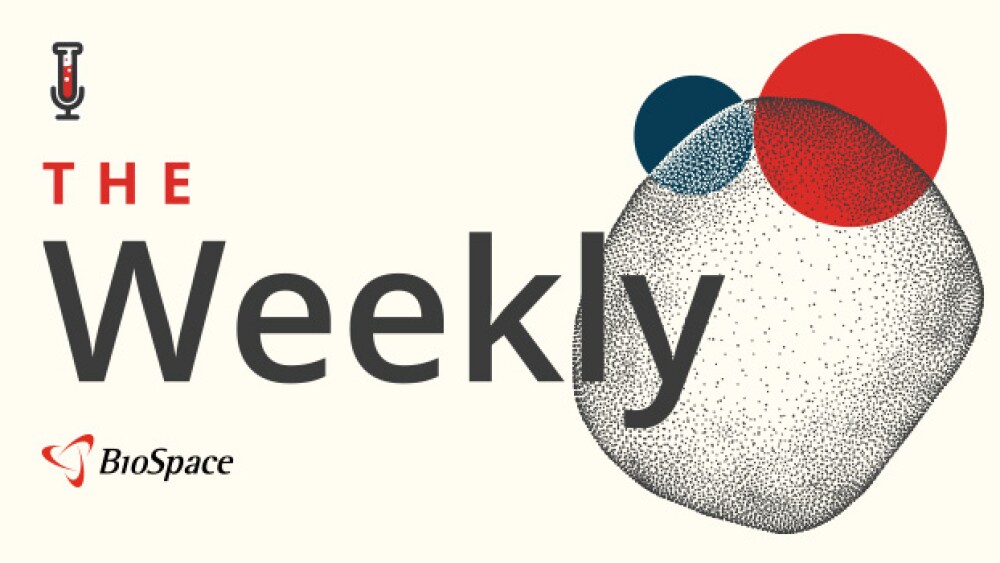The Janssen Pharmaceutical Companies of Johnson & Johnson announced today long-term results from the Phase 3 ALCYONE study showing that the addition of DARZALEX® (daratumumab) to bortezomib, melphalan and prednisone (VMP) continued to demonstrate significant improvement in progression-free survival (PFS) in patients with newly diagnosed multiple myeloma who are ineligible for autologous stem cell transplantation (ASCT).1
|
SAN DIEGO, /PRNewswire/ -- Janssen Pharmaceutical Companies of Johnson & Johnson announced today long-term results from the Phase 3 ALCYONE study showing that the addition of DARZALEX® (daratumumab) to bortezomib, melphalan and prednisone (VMP) continued to demonstrate significant improvement in progression-free survival (PFS) in patients with newly diagnosed multiple myeloma who are ineligible for autologous stem cell transplantation (ASCT).1 These data (Abstract #156), as well as updates from the Phase 2 LYRA (Abstract #152) and GRIFFIN (Abstract #151) studies in patients with multiple myeloma, were featured during an oral abstract session at the 60th American Society of Hematology (ASH) Annual Meeting in San Diego, CA. Long-term Phase 3 ALCYONE results for DARZALEX frontline combination therapy At a median follow-up of 27.8 months, study results showed the addition of DARZALEX to VMP reduced the risk of disease progression or death by 57 percent compared to VMP alone (Hazard Ratio [HR] = 0.43; 95 percent confidence interval [CI] 0.35-0.54, p<0.0001).1 DARZALEX-VMP resulted in a 24-month PFS rate of 63 percent compared to 36 percent with VMP alone.1 The median PFS for DARZALEX-VMP has not yet been reached, whereas the control arm of VMP alone has a median PFS of 19.1 months.1 In addition, a significantly higher overall response rate (ORR) [91 percent vs. 74 percent, respectively] was observed with the DARZALEX combination compared to VMP alone.1 DARZALEX-VMP resulted in deeper responses, significantly improving the rate of very good partial response (VGPR) or better (73 percent vs. 50 percent) and more than doubling the rate of stringent complete response (sCR) [22 percent vs. 8 percent] compared to VMP alone.1 DARZALEX-VMP induced a higher rate of sustained minimal residual disease (MRD) negativity compared to VMP alone (10 percent vs. 2 percent, respectively).1 The previously reported primary results of this study formed the basis of the U.S. Food and Drug Administration approval of DARZALEX in combination with VMP in patients with newly diagnosed multiple myeloma who are ineligible for ASCT. "Longer-term data from the pivotal ALCYONE trial show that daratumumab combination therapy continued to show improvement in progression-free survival and response rates in newly diagnosed patients with multiple myeloma, including older patients who are less likely to respond to treatment," said Meletios A. Dimopoulos, M.D., Professor and Chairman of the Department of Clinical Therapeutics at the National and Kapodistrian University of Athens School of Medicine, Athens, Greece, and principal investigator. "These promising results support the use of daratumumab earlier in the treatment paradigm when transplant ineligible patients are more likely to benefit from therapy, and that continued therapy with daratumumab confers benefit." In the ALCYONE study, the most common Grade 3/4 treatment-emergent adverse events (TEAEs) during Cycle 10 and onward for DARZALEX-VMP included anemia (4 percent), neutropenia (2 percent) and bronchitis (1 percent).1 No new safety signals emerged, and Grade 3/4 infections continued to be manageable.1 Phase 2 LYRA and GRIFFIN data support efficacy and safety of DARZALEX in newly diagnosed patients, including those who are eligible for high-dose therapy/ASCT, and in relapsed patients Response rates from the Phase 2 LYRA study were presented for the investigational use of DARZALEX plus cyclophosphamide, bortezomib and dexamethasone (CyBorD) in patients with newly diagnosed and relapsed multiple myeloma.2 The ORR and VGPR or better rates in 86 newly diagnosed patients were 79 percent and 44 percent, respectively, after 4 Cycles and increased to 81 percent and 56 percent, respectively, at the end of induction (median 6 Cycles).2 In addition, the VGPR or better rate in 14 relapsed multiple myeloma patients was 57 percent after 4 Cycles and increased to 64 percent at the end of induction, and the ORR stayed consistent at 71 percent (median 7.5 Cycles).2 The 18-month PFS rate was 78 percent in non-transplant, newly diagnosed patients and 53 percent in relapsed patients.2 Additionally, the study, which investigated splitting the first dose of DARZALEX to shorten the infusion time on Cycle 1, Day 1, showed a safety profile consistent with previous studies.2 Infusion reactions (IRs) occurred in 49 percent of patients on Cycle 1, Day 1 (C1D1) and four percent on Cycle 1, Day 2 (C1D2).2 Fifty-four percent of newly diagnosed patients experienced IRs, the most frequent being chills (14 percent), dyspnea, pruritus and nausea (8 percent each) and cough (7 percent).2 Fifty-seven percent of relapsed patients experienced IRs, the most frequent being cough (21 percent), hyperhydrosis, dyspnea and chills (7 percent each).2 Only two patients experienced a Grade 3 IR, and there were no Grade 4 IRs. There were no DARZALEX discontinuations due to IRs.2 Median infusion time was 4.5 hours for C1D1 and 3.8 hours for C1D2.2 Grade 3/4 TEAEs were reported for 56 percent of patients, and the most common (≥10 percent) was neutropenia (13 percent).2 Data presented on the Phase 2 GRIFFIN study investigated DARZALEX in combination with bortezomib, lenalidomide and dexamethasone (VRd) in a 16-patient safety cohort of newly diagnosed patients with multiple myeloma who were eligible for high-dose therapy and ASCT.3 Results showed that by the end of consolidation therapy following ASCT, all patients enrolled in the safety run-in obtained VGPR or better, and 63 percent achieved complete response (CR) or better, including 25 percent of patients who achieved sCR.3 Additionally, 94 percent of patients remained progression free on study treatment at a median follow-up of 16.8 months.3 In addition, 8 of the 16 patients (50 percent) were MRD negative at a level of 10-5 by the end of consolidation.3 Fourteen patients (88 percent) experienced Grade 3/4 TEAEs with 10 (63 percent) related to treatment with DARZALEX.3 The most common Grade 3/4 TEAEs (≥10 percent) included neutropenia, pneumonia, thrombocytopenia, lymphopenia, febrile neutropenia, leukopenia, rash and hypophosphatemia.3 Thirteen patients (81 percent) experienced infections of any Grade, including upper respiratory tract infection (six patients), pneumonia (four patients), bronchitis (two patients) and otitis and viral gastroenteritis (two patients each).3 No deaths due to serious adverse events (SAEs) were reported and no patient discontinued treatment due to an AE.3 These data suggest that DARZALEX induction does not negatively impact stem cell mobilization as all 16 patients underwent successful mobilization with subsequent ASCT. 3 "We are pleased with the consistent results and growing evidence for DARZALEX therapy in the treatment of multiple myeloma," said Yusri Elsayed, M.D., MHSc., Ph.D., Vice President, Hematologic Malignancies Disease Area Leader, Janssen Research & Development, LLC. "The split first infusion may provide an alternative dosing option for patients who may be candidates for DARZALEX treatment but who want or need a different infusion schedule." About the ALCYONE Trial1 About the LYRA Trial2 About the GRIFFIN Trial3,4 About DARZALEX® (daratumumab) Injection, for Intravenous Infusion In the U.S., DARZALEX received initial FDA approval in November 2015 as a monotherapy for patients with multiple myeloma who have received at least three prior lines of therapy, including a proteasome inhibitor (PI) and an immunomodulatory agent, or who are double refractory to a PI and an immunomodulatory agent.17 DARZALEX received additional approvals in November 2016 in combination with lenalidomide and dexamethasone, or bortezomib and dexamethasone, for the treatment of patients with multiple myeloma who have received at least one prior therapy.18 In June 2017, DARZALEX received approval in combination with pomalidomide and dexamethasone for the treatment of patients with multiple myeloma who have received at least two prior therapies, including lenalidomide and a PI.19 Most recently, in May 2018, DARZALEX received approval in combination with bortezomib, melphalan and prednisone for the treatment of patients with newly diagnosed multiple myeloma who are ineligible for ASCT, making it the first monoclonal antibody approved for newly diagnosed patients with this disease.20 In August 2012, Janssen Biotech, Inc. entered into a global license and development agreement with Genmab A/S, which granted Janssen an exclusive license to develop, manufacture and commercialize DARZALEX.21 For the full U.S. Prescribing Information, please visit www.DARZALEX.com. About Multiple Myeloma IMPORTANT SAFETY INFORMATION5 CONTRAINDICATIONS WARNINGS AND PRECAUTIONS Pre-medicate patients with antihistamines, antipyretics, and corticosteroids. Frequently monitor patients during the entire infusion. Interrupt infusion for reactions of any severity and institute medical management as needed. Permanently discontinue therapy if an anaphylactic reaction or life-threatening (Grade 4) reaction occurs and institute appropriate emergency care. For patients with Grade 1, 2, or 3 reactions, reduce the infusion rate when re-starting the infusion. To reduce the risk of delayed infusion reactions, administer oral corticosteroids to all patients following DARZALEX® infusions. Patients with a history of chronic obstructive pulmonary disease may require additional post-infusion medications to manage respiratory complications. Consider prescribing short- and long-acting bronchodilators and inhaled corticosteroids for patients with chronic obstructive pulmonary disease. Interference with Serological Testing – Daratumumab binds to CD38 on red blood cells (RBCs) and results in a positive Indirect Antiglobulin Test (Indirect Coombs test). Daratumumab-mediated positive indirect antiglobulin test may persist for up to 6 months after the last daratumumab infusion. Daratumumab bound to RBCs masks detection of antibodies to minor antigens in the patient's serum. The determination of a patient's ABO and Rh blood type are not impacted. Notify blood transfusion centers of this interference with serological testing and inform blood banks that a patient has received DARZALEX®. Type and screen patients prior to starting DARZALEX®. Neutropenia – DARZALEX® may increase neutropenia induced by background therapy. Monitor complete blood cell counts periodically during treatment according to manufacturer's prescribing information for background therapies. Monitor patients with neutropenia for signs of infection. DARZALEX® dose delay may be required to allow recovery of neutrophils. No dose reduction of DARZALEX® is recommended. Consider supportive care with growth factors. Thrombocytopenia – DARZALEX® may increase thrombocytopenia induced by background therapy. Monitor complete blood cell counts periodically during treatment according to manufacturer's prescribing information for background therapies. DARZALEX® dose delay may be required to allow recovery of platelets. No dose reduction of DARZALEX® is recommended. Consider supportive care with transfusions. Interference with Determination of Complete Response – Daratumumab is a human IgG kappa monoclonal antibody that can be detected on both the serum protein electrophoresis (SPE) and immunofixation (IFE) assays used for the clinical monitoring of endogenous M-protein. This interference can impact the determination of complete response and of disease progression in some patients with IgG kappa myeloma protein. Adverse Reactions – The most frequently reported adverse reactions (incidence ≥20%) in clinical trials were: infusion reactions, neutropenia, thrombocytopenia, fatigue, nausea, diarrhea, constipation, vomiting, muscle spasms, arthralgia, back pain, pyrexia, chills, dizziness, insomnia, cough, dyspnea, peripheral edema, peripheral sensory neuropathy and upper respiratory tract infection. In patients who received DARZALEX® in combination with bortezomib, melphalan, and prednisone (DVMP), the most frequently reported adverse reactions (incidence ≥20%) were: upper respiratory tract infection (48%), infusion reactions (28%), and peripheral edema (21%). Serious adverse reactions (≥2% compared to the VMP arm) were pneumonia (11%), upper respiratory tract infection (5%), and pulmonary edema (2%). Treatment-emergent Grade 3-4 hematology laboratory abnormalities ≥20% were lymphopenia (58%), neutropenia (44%), and thrombocytopenia (38%). In patients who received DARZALEX® in combination with lenalidomide and dexamethasone, the most frequently reported adverse reactions (incidence ≥20%) were: upper respiratory tract infection (65%), infusion reactions (48%), diarrhea (43%), fatigue (35%), cough (30%), muscle spasms (26%), nausea (24%), dyspnea (21%) and pyrexia (20%). The overall incidence of serious adverse reactions was 49%. Serious adverse reactions (≥2% compared to Rd) were pneumonia (12%), upper respiratory tract infection (7%), influenza (3%), and pyrexia (3%). Treatment-emergent Grade 3-4 hematology laboratory abnormalities ≥20% were neutropenia (53%) and lymphopenia (52%). In patients who received DARZALEX® in combination with bortezomib and dexamethasone, the most frequently reported adverse reactions (incidence ≥20%) were: peripheral sensory neuropathy (47%), infusion reactions (45%), upper respiratory tract infection (44%), diarrhea (32%), cough (27%), peripheral edema (22%), and dyspnea (21%). The overall incidence of serious adverse reactions was 42%. Serious adverse reactions (≥2% compared to Vd) were upper respiratory tract infection (5%), diarrhea (2%) and atrial fibrillation (2%). Treatment-emergent Grade 3-4 hematology laboratory abnormalities ≥20% were lymphopenia (48%) and thrombocytopenia (47%). In patients who received DARZALEX® in combination with pomalidomide and dexamethasone, the most frequent adverse reactions (>20%) were fatigue (50%), infusion reactions (50%), upper respiratory tract infection (50%), cough (43%), diarrhea (38%), constipation (33%), dyspnea (33%), nausea (30%), muscle spasms (26%), back pain (25%), pyrexia (25%), insomnia (23%), arthralgia (22%), dizziness (21%), and vomiting (21%). The overall incidence of serious adverse reactions was 49%. Serious adverse reactions reported in ≥5% patients included pneumonia (7%). Treatment-emergent hematology Grade 3-4 laboratory abnormalities ≥20% were anemia (30%), neutropenia (82%), and lymphopenia (71%). In patients who received DARZALEX® as monotherapy, the most frequently reported adverse reactions (incidence ≥20%) were: infusion reactions (48%), fatigue (39%), nausea (27%), back pain (23%), pyrexia (21%), cough (21%), and upper respiratory tract infection (20%). The overall incidence of serious adverse reactions was 33%. The most frequent serious adverse reactions were pneumonia (6%), general physical health deterioration (3%), and pyrexia (3%). Treatment-emergent Grade 3-4 hematology laboratory abnormalities ≥20% were lymphopenia (40%) and neutropenia (20%). DRUG INTERACTIONS Effect of Daratumumab on Other Drugs: The coadministration of DARZALEX® with bortezomib or pomalidomide did not affect the pharmacokinetics of bortezomib or pomalidomide. About the Janssen Pharmaceutical Companies of Johnson & Johnson We are Janssen. We collaborate with the world for the health of everyone in it. Learn more at www.janssen.com. Follow us at @JanssenGlobal and @JanssenUS. Janssen Research & Development, LLC and Janssen Biotech, Inc. are part of the Janssen Pharmaceutical Companies of Johnson & Johnson. Cautions Concerning Forward-Looking Statements 1 Dimopoulos, Meletios et al. One-year Update of a Phase 3 Randomized Study of Daratumumab Plus Bortezomib, Melphalan, and Prednisone (D-VMP) Versus Bortezomib, Melphalan, and Prednisone (VMP) in Patients (Pts) With Transplant-ineligible Newly Diagnosed Multiple Myeloma (NDMM): ALCYONE. 2018 American Society of Hematology Annual Meeting. December 2018. Media Inquiries: Bernadette King Investor Relations: Lesley Fishman U.S. Medical Inquiries:
SOURCE Janssen Oncology |




